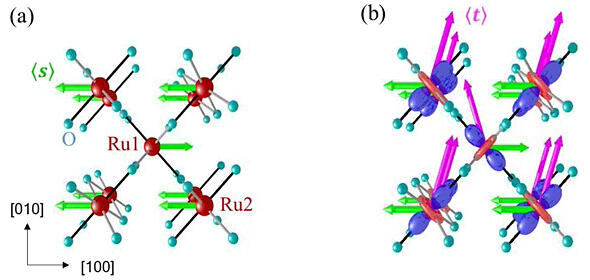A research team led by Project Assistant Professor Norimasa Sasabe and Professor Masaichiro Mizumaki of the Faculty of Advanced Science and Technology at Kumamoto University, in collaboration with Osaka Metropolitan University and the National Institute for Materials Science, conducted detailed research on the antiferromagnetic state of the rutile compound RuO2. The research team announced that the observation of X-ray magnetic circular dichroism response (XMCD, a phenomenon where the absorption coefficient of circularly polarized X-ray transmitted through a magnetic material differ for leftward and rightward circularly polarized X-ray) will theoretically be enabled in the antiferromagnetic state in the colinear direction. It is expected to promote research and development of materials with peculiar spatial and time symmetries and to contribute to the creation of materials and substances that lead to innovation. The results were published in the November 24 issue of Physical Review Letters, a journal of the American Physical Society.

Provided by Kumamoto University
In "symmetry breaking," the loss (breaking) of spatial reversal symmetry causes electric polarization (the electrons and protons in an object are attracted in one direction, resulting in the entire object being electrically polarized, thereby in some cases giving rise to object with two distinct poles), whereas the breaking of time reversal symmetry induces magnetism.
Cross-correlation responses, such as electric polarization by a magnetic field or magnetization control by an electric field, have been discovered. These phenomena are not accounted for in Maxwell's equations.
Electric polarization requires the breaking of spatial reversal symmetry. When spatial reversal in the material's crystal structure is absent, electric polarization occurs. However, in a crystal structure with spatial reversal, the breaking of spatial reversal symmetry by becoming ferromagnetic can lead to the occurrence of electric polarization. In the former case, the electric polarization is controlled by the electric field, while in the latter case, the electric polarization is controlled by manipulating the magnetization state with a magnetic field.
In this study, the research group performed electronic structure analysis and X-ray magnetic circular dichroism (XMCD) response simulations on RuO2, a rutile structure material with antiferromagnetic ordering in the [100] direction. XMCD is a powerful method for identifying the spin and orbital motion of electrons within a material.
When X-rays were incident from the [100] direction, no XMCD was observed, whereas XMCD appeared when X-rays were incident from the [010] direction. The XMCD in RuO2 is derived from anisotropic magnetic dipoles, providing evidence for the presence of a ferromagnetic component of anisotropic magnetic dipoles induced in antiferromagnets.
A theoretical proposal posits that the anisotropic magnetic dipole term plays an important role in the anomalous Hall effect. This contributes to understanding the behavior of anisotropic magnetic dipoles and their electronic state through synchrotron radiation measurements on the basis of XMCD and resonant X-ray scattering.
Sasabe said, "We are delighted that our research findings have been published in the prestigious journal, Physical Review Letters, and were also selected for the Editors, Suggestions and Front Cover. Physical phenomena such as superconductivity arise from the symmetry of materials. In this study, we conducted theoretical research on the anisotropic magnetic components arising from distinctive symmetries. In the future, we aim to elucidate the relationship between these anisotropic magnetic components and physical phenomena, such as unconventional superconductivity and cross-correlation responses."
Journal Information
Publication: Physical Review Letters
Title: Ferroic Order for Anisotropic Magnetic Dipole Term in Collinear Antiferromagnets of (t2g)4 System
DOI: 10.1103/PhysRevLett.131.216501
This article has been translated by JST with permission from The Science News Ltd. (https://sci-news.co.jp/). Unauthorized reproduction of the article and photographs is prohibited.




